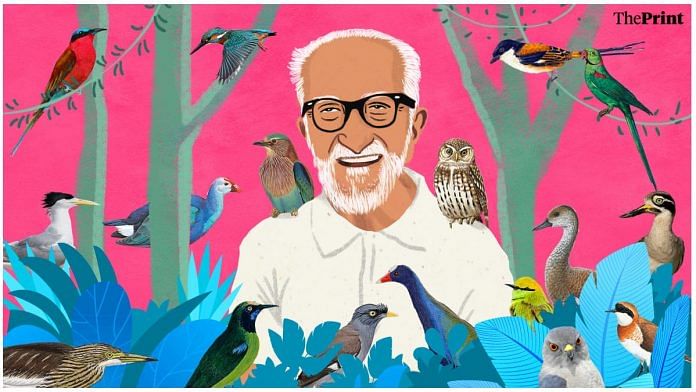For Salim Ali, one could love birds from a distance—not just physically, but away from the dizziness of academic jargon.
“I…am thoroughly unmoved by what name one ornithologist chooses to dub a bird that is familiar to me,” he said.
Dubbed as the “Birdman of India”, Salim Ali was a pioneer in ornithology who conducted systematic bird surveys across India, besides writing several books on his feathered friends to popularise the study of birds. What started as a young boy shooting sparrows with a toy gun, evolved into the publication of the subcontinent’s go-to bird book, Handbook of the Birds of India and Pakistan, and a Padma Vibhushan in 1976.
Salim Ali passed away in 1987, but India is still dotted with sanctuaries, institutions and birds named after him.
Why Salim Ali wasn’t your next-door bird lover
History needs to remember the Birdman, and not simply because he championed the cause of birds and worked relentlessly for their conservation. It needs to know why.
In a speech delivered in 1985, Salim Ali said, “I despise purposeless killing, and regard it as an act of vandalism, deserving the severest condemnation. But my love for birds is not of the sentimental variety. It is essentially aesthetic and scientific.”
India’s Birdman, with his scientific bent of mind despite having little institutional backing, was a researcher at mind and aesthetician at heart. For him, the love of birds—and nature—needed to go beyond the matters of the heart. Ali made a clear distinction between his approach, and the Gandhian ideal of ahimsa, which he thought of as a roadblock for systematic study.
Bordering on the moral debate between killing birds for research and preserving life at all costs, Salim Ali took a contested position. For him, a “practical and pragmatic approach” was necessary, with its undertones of non-adherence to ahimsa. However, it would be neither pragmatic nor practical to dismiss Salim Ali’s contribution to ornithology and history.
Also read: Nagaland’s beloved ‘Longleng’ creates ‘world record’, clocks 1,50,000 km in 4 years
A boy meant for the wild
Ali’s academic distance wasn’t just a later, sophisticated development in life. Born on 12 November 1896, the bird enthusiast failed to maintain a steady academic record, from barely passing the matriculation exam of the Bombay University to dropping out of St. Xavier’s College in his first year. What attracted the innate scientist in him was the forest that surrounded his family’s tungsten mines in erstwhile Burma. Having honed his skills in the forests and made connections with notable scientists at the Forest Service in Burma, Ali returned to India in 1917, with an abandoned university degree and eyes full of dreams.
Salim Ali’s return to India was followed by Father Ethelbert Blatter’s— a pioneer botanist in British India at St. Xavier’s College—advice for him to pursue zoology. But the path towards a professional job was rocky. Lacking formal education, Ali was refused the job at the Zoological Survey of India. Later on, he went to Germany and studied under the notorious Erwin Stresemann, who later on became his guru. The event marked Ali’s wide recognition in German ornithology organisations. In 1950, Ali would strike an assistant position with Swiss ornithologist Alfred Schifferli in India.
Also read: India’s green energy goals have a serious problem – the Great Indian Bustard
Ali’s place in India during Independence and after
Despite having gathered wide recognition in German ornithology circles, Ali returned to an India in 1930 that lacked funds for scientific research on birds. The Bombay Natural History Society (BNHS), with which Salim Ali was acquainted since his boyhood dreams of bird studies, was in shambles. Disappointed, he moved to Kihim, a village near Mumbai, where he started studying the mating habits of the baya weaver in the tradition of Mughal naturalists. Spurred by his growing fondness for a scientific study never attempted before, Ali carried out systematic surveys in the princely states of Hyderabad, Travancore, Gwalior, Indore, Bhopal, and Cochin. These surveys would later on earn him the title of ‘India’s Birdman.’
While India was fighting for Independence, Ali was on his way to formalise ornithology as a discipline. By now, with more pressing issues at hand, state and central governments were deflecting funds from institutes such as The Bombay Natural History Society, a 100-year-old research and conservation committee. In its dying embers, Salim Ali wrote to Jawaharlal Nehru for its revival. From there, the map to a developed ornithology discipline in India was charted.
In the mid 1940s, Indira Gandhi, a fond bird enthusiast, was reading Salim Ali’s Book of Indian Birds in the Naini Central Jail. In the 1960s, the Indian Council for Agricultural Research opened a new economic ornithology unit. In the 1970s, Salim Ali was at the forefront of the Save Silent Valley project, a movement to protect Silent Valley National Park in Kerala against biodiversity damage by hydroelectric plants. In 1985, he was nominated to the Rajya Sabha.
For young birdwatchers, Ali has a word. It is to love birds, without institution and sentimentality, so “when people retire from their official chair, they don’t know what to do. Perhaps with birdwatching, they would enjoy their pensions longer.”



